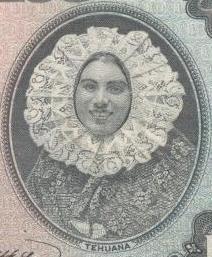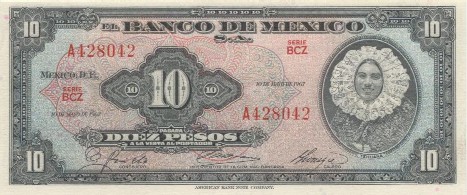ESTELITA RUIZ, THE MN$10 BANKNOTE
Pick 35 et al, Anecdotes about Banknotes
Posted June,
2005

In the 1930's, through the decision of President Lazaro Cardenas, the image of Estel Ruiz Velazquez, La Tehuana, graces the 10 peso banknote for almost four decades. In that period of time she never once received one bit of recognition in accordance with the declaration that she made last April, a little before dying at the age of 92 in poverty without one cent to her name.
In his article "A Estela Estelita Ruiz Velazquez" which appeared in the El Boletin Numismatico, number 202 (January - April, 2004), Dr. Luis M. Gomez Wulshner tells that Estela did not accept nor receive any type of payment for having her face being placed on these banknotes which circulated by the millions in Mexico.
In Mexico and abroad, the brown face of Estelita, at 25 years of age, was made famous and was a symbol of the history of the Mexican banknote. A few months ago at 92 years of age, death overtook the woman who left Cardenas very impressed with her native beauty and demeanor.
It all began when Cardenas ordered the design renovation of all of the Mexican banknotes with illustrations of his own country. That is, they should take into account the "agreements of national and indigenous thinking of the period." For the ten peso banknote a regional dress contest was held in 1936. It was organized by the Pensions Agency (a precursor of the ISSSTE), according to Dr. Gomez Wulshner.
The contest took place in the Fonton Mexico, and when they showed General Cardenas the winning photo, he became charmed with the image of
La Tehuana.
After seeing it reproduced
millions of times, she liked to mention with pride and sauciness that "no woman
has ever been in as many male hands as I," And she was right.
The history and image of Estela are linked with the path that Mexican numismatics has taken, says Jose Antonio Batiz Vazquez, a historian who has dedicated many years of his life to the study of the economic history in general and in particular to themes related to money and banking in Mexico.
Batiz spoke with La Cronica in his Bancamex office, relating the many anecdotes related to banknotes in which a gereat part of Mexican history can be summarized. But not only that, but also there are stories of impossible romances, like the one of the banker who, because he was not written back to, ordered the image of the woman who scorned him to be printed by the thousands on this banknote.

At 25 years of age this woman posed for a photo that would carry her to fame. The anecdotes relating to this banknote did not stop here. The whole thing began, as Jose Antonio Batiz (the present president of the Numismatic Society of Mexico, A.C.) told, in the times of the first Mexican empire when Iturbide made the first experiment of issuing the first banknotes in denominations of one, two, and ten pesos with a very simple manufacture and format. The idea was to finance the nascent regime. The banknotes only circulated that year and they were not accepted very well by the population, which for more than 300 years was accustomed to using and managing only silver coins. One of the important things that came out of all of this was that the denominations were made in pesos."
It was not until 1865 that banknotes began to circulate again, this time issued by the Bank of London and Mexico (Banco de Londres y Mexico). At that time the majority of the notes were printed abroad, primarily by the American Banknote Company of New York. It was for many years the most recognized steel printing company. This was the same company that worked for Mexico until 1969, which was the date that a Mexican manufacturing plant was founded along these same lines.
Steel engraving was a very
complex operation; it was what constituted an element of security along with the
type of paper and the ink, according to this specialist.
Beginning in 1925, another stage in banknote history was begun with the creation of the Bank of Mexico (Banco de Mexico). It was the only one authorized from this date to issue paper money. Thus began the modern period of Mexican paper money in which illustrations based on national heroes, monuments, and buildings in the country prevailed.
The Reign of the Revolutionary "Bimbliquess"
One anecdote states that one day quite suddenly General Pancho Villa was told that there was no money with which to pay expenses. The Centurion of the North in the usual practical sense that characterized him cried out: "No money? Well, lets make some!" And they did. Thus appeared the "bimbliquess," an offspring of the sheer necessity of exchange that not even David Ricardo could imagine.
The author of the book History of Paper Money in Mexico (Historia del Papel Moneda en Mexico) also stated that another stellar banknote moment took place during the Mexican Revolution that "in good measure was financed by the issuance of bimbliques and cardboard money. Revolutionary leaders, businessmen, hacienda owners, and other private citizens issued these types of money, according to the above-mentioned book, which was published by the National Bank of Mexico (Banco Nacional de Mexico) in 1984.
But not only Villa's indomitable spirit drove the "bilimbiquisation" of the economy. General Venustiano Carranza also printed a great number of these in Mexico City (Mexico, D.F.) and in Veracruiz towards where he had to flee due to Zapata's advancing troops.
Some of these banknotes looked
like modern Metro (subway) tickets, theatre or bullfighting tickets, fee
receipts, raffle tickets, or little pieces of paper for messages. All of these
do not look like the banknotes that we think of today. Besides, some of them had
an extended life, more or less, but others a tremendously short one, depending
on the fluctuations of the revolutions that were like a Ferris Wheel.
Ricardo Pacheco Colin, La Cronica de Hoy, Wednesday,
August 18, 2004
www.cronica.com.mx/nota.php?idc=137133
Translated by James S. Cameron
|
|
|